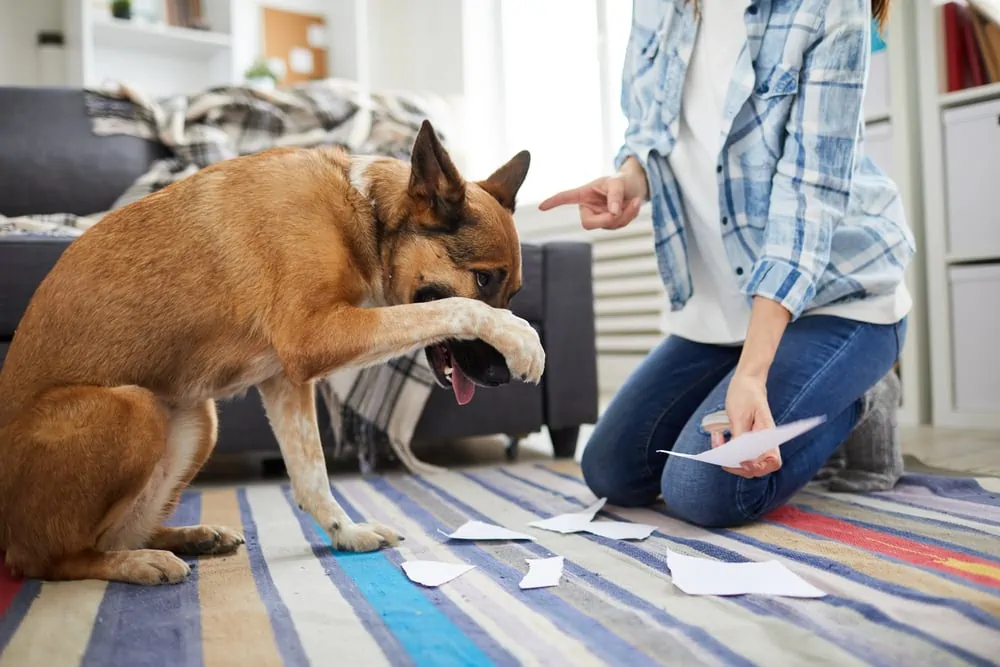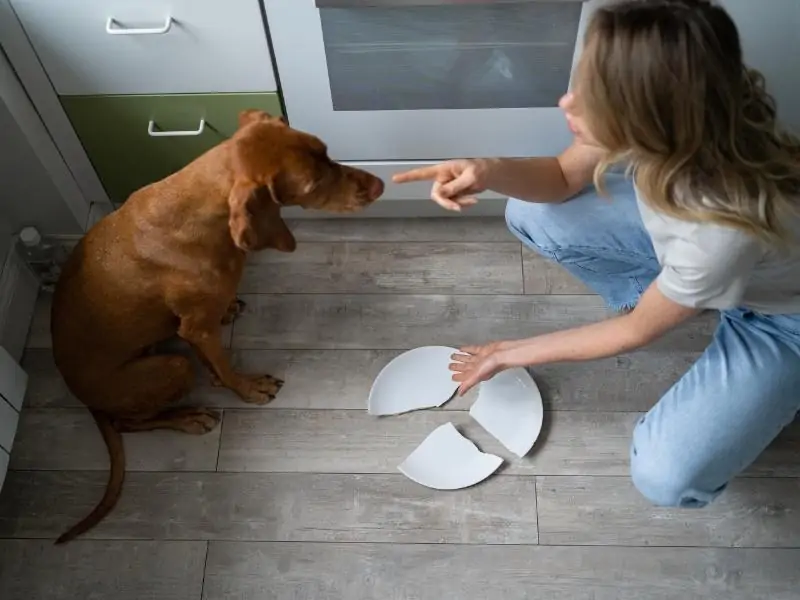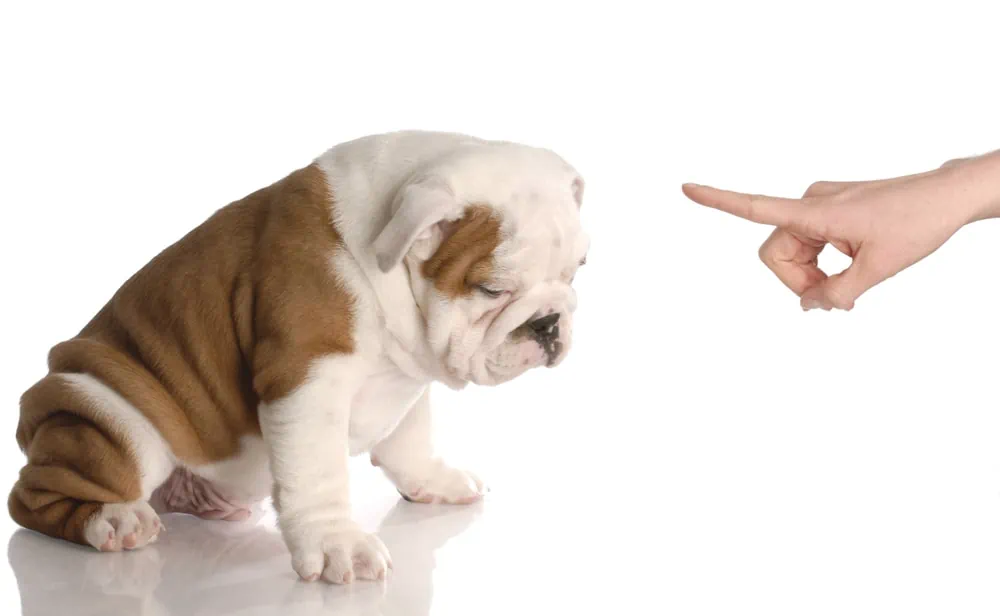We all have those days where we’re not quite ourselves. Sometimes our frustration affects those who least deserve it. Sometimes that cute face is just the final straw in a series of unending hardships and bitter defeats at the hands of a careless, unemotional meaningless world – and we just want to haul off and snuff out the only source of joy in our lives by taking a big, meaty, sweaty fist, to that stinky pink snout. Just kidding of course, but it is true this does happen on occasion. The question is where do you go from here?
I Hit My Dog Out of Anger: Where do I Go From Here?
If you’ve gone so far as to strike your dog out of anger, you might be concerned over what your next step should be.
So just what do you do if you’ve hit your dog out of anger?
What do you do after you hit your dog out of anger?
After you hit your dog out of anger it is important to reestablish your bond so they don’t develop a deep fear of you. Start by changing your habits as a trainer and using positive training techniques. You might be surprised at just how forgiving they can be if your love for them is genuine.
In this article, I will help you to develop a better relationship with your dog and use better discipline techniques.
Dog Owners should be Assertive but Calm
A dog owner should exhibit calm but assertive energy.
Unfortunately, it has become commonplace in our culture to associate an alpha male or an alpha dog with an overly aggressive and domineering stereotype.
More recent research on wolf packs reveals that such domineering behavior is more likely to get a wolf kicked out of the pack than it is to result in him remaining as the pack leader.
Strength is important, but so is stability (source).
If you’ve hit your dog out of anger, you should do your best to gain better control of your emotions so that you do not do so in the future.
A more timid dog might become afraid of you, which is not what you want.
Also, in the case of an alpha dog, it makes you look unstable.
You can lose the respect of your dog which will make proper discipline that much harder.
Dogs can sense anxiety, and a more dominant dog will take this as a cue to take charge (source).
Do dogs Forgive Owners?

If you hit your dog, one of the first things you will probably ask yourself is “Do dogs stay mad at you?”
The good news is, if you have a solid relationship with your dog, dogs can be remarkably forgiving.
Since dogs are usually regarded as part of the family, we have a tendency to attribute human characteristics to them that they don’t possess.
However, if you begin to make a habit of hitting your dog, especially if the dog does not understand why then you will only train them to be anxious and fearful around you.
While dogs do experience emotions and can get angry, there is no evidence to suggest that they can connect motives to emotion the way humans do.
Dogs tend to operate more at the moment instead of holding onto long-term grudges.
Behavior that appears angry, such as barking or snapping, is more likely to be an indicator of frustration or momentary irritation than it is pent-up anger.
As long as having hit your dog was uncharacteristic of your dog-human relationship, they will likely forget about it within a day or two, if not even sooner (source).
Reading your Dog’s Behavior
Dogs can be hard to read, and if they appear irritated, it can be difficult to discern why your dog is mad.
It may be an environmental issue totally unrelated to you.
Some breeds, like Border Collies, require high levels of activity and can become irritable and destructive if not given something to do (source).
Dogs can experience emotions like suspicion, disappointment, and annoyance.
They can become anxious if their schedule is changed or if they’re alone for long periods of time.
The dog could also be in pain but doesn’t wish to show it. It is instinctive for dogs to conceal pain since it can be viewed as a sign of weakness and vulnerability.
If anxiety, irritation, or lethargy last for more than a few days, then it might be a legitimate cause for concern (source).
If you witness any major changes in your dog’s behavior, such as loss of appetite, depression, or an increase in aggressive behavior, you should take your dog to the vet to get them checked out (source).
A loss of appetite can be a good indicator that your dog is sick.
If your dog only eats once a day, and well under the recommended amount, he may be having serious stomach problems.
Sending the Right Signals

If you’re the type of person who’s constantly on edge, they may very well be feeding off of that.
A dog that is consistently abused may also begin to exhibit aggressive behavior out of frustration.
When necessary, discipline should be brief, and then things should quickly return to normal.
If the dog was happy before the discipline became necessary, then they will be more likely to respond to proper discipline in a desire to return to the way things were before (source).
Proper discipline will be difficult to achieve if you and your dog have no connection with each other.
A dog that loves and trusts you will naturally seek your approval and wish to avoid your disapproval.
Take time out of your day to walk your dog, play with them, and show them affection.
Not all dogs are cuddly and affectionate though, and they may prefer some type of high-energy activity.
When giving commands to your dog, use very short and simple commands like “No!” or “Come.”
Some owners get into the habit of yelling long sentences at their dogs, which does little but cause confusion.
Also, by constantly yelling at your dog, you are sending all the wrong signals.
Leaders are not emotionally unstable; they are calm, collected, and assertive.
Proper Discipline for Dogs
Proper discipline is necessary for a healthy relationship with your dog. Having clearly defined boundaries makes life easier for both of you.
This does not require you to be domineering or abusive, but you do need to be assertive.
The timider the dog, the less assertive you will need to be.
The more dominant the dog, the more assertive, you will need to be (source).
Should You Ever Hit Your Dog?
The predominant opinion seems is that you should never hit your dog for any reason.
However, without some form of discipline, you can quickly lose control of your dog.
This should take the form of positive discipline and should be done close to the time of the undesired behavior so that the dog is able to associate the discipline with the act (source).
Negative punishment involves taking something away that the dog values, like attention, treats, or playtime.
If you have a dog that is prone to biting, isolating the dog immediately after can be an effective form of negative punishment (source).
Remember, a dog that you’ve developed a relationship with will be far more responsive to you without the need for harsh punishment.
Positive reinforcement in the form of rewards is best where possible, and you should constantly reward positive behavior with praise and affection.
Consistency is important too.
If you forget to reward or punish certain behaviors, your dog may quickly lapse back into old habits.
The Use of Tone and the Corrective Tap

While difficult to implement properly since our emotional states vary, positive punishment is preferred.
Among the most recommended forms of positive punishment would be the corrective tap or the firm voice.
Your dog will usually want to please you, and over time little more than a tone of disapproval should be needed to correct negative behavior.
Many experienced dog trainers recommend the “corrective tap,” which is a light tap on the nose with two fingers accompanied by a tone of disapproval.
This does not involve afflicting pain; it is first and foremost a show of disapproval (source).
To use the corrective tap:
- Go to your dog when they exhibit unwanted behavior; do not call them to you
- Tell them, “NO!” in a deep, unsettling voice
- Within a second or two of scolding your dog, lightly but abruptly tap them on the nose
The reason that you want to go to where your dog is instead of calling them towards you is that you don’t want them to associate the punishment with coming when you call.
This will make it harder to make your dog come when you need them to.
Your tone of voice is important and should be proportionate to the offense. I
f you’re constantly yelling, they’ll eventually tune you out (source).
Some trainers recommend that you don’t even use your hand to discipline the dog since they may begin to recoil from your touch.
Again, the idea is to show disapproval and gain the dog’s attention, not to inflict pain.
Over time, it may not even be necessary to use the tap.
Your tone of voice will be sufficient.
Dogs with Severe Behavior Issues
For dogs with severe behavioral issues, you may want to contact a behavioral specialist.
A dog should not exhibit aggressive behavior towards you for disciplining them reasonably.
Some of the more aggressive methods used to bring dogs into submission like kicking, hitting, grabbing by the muzzle, or yelling at them may expose you or them to bodily injury (source) and should always be avoided.
Some milder techniques commonly used by experts include the alpha roll (source).
Some of these techniques are used by the well-known, if sometimes controversial, Cesar Millan on his cable television show The Dog Whisperer.
The types of discipline used on these shows tend to involve dogs with serious behavior issues and that have a tendency to try to dominate their owners (source).
The alpha roll is simply a technique where you roll the dog on its back in a submissive pose, similar to what a mother dog would do to a puppy (source).
It’s important to keep in mind that he has years of experience with dogs, and there is always a risk of injury when attempting this with more aggressive dogs.
Animal Cruelty Laws
These more aggressive forms of discipline are highly controversial, and many claim that they constitute cruelty to animals.
There is a great deal of confusion over animal cruelty laws, and part of this is due to the fact that such laws vary widely by state.
State Laws
Despite what many people might think, it is technically not illegal to hit your dog.
It is, however, illegal to “beat” or “cruelly beat” your dog in most states.
Most state laws have clauses that prohibit excessive behavior such as “torturing, tormenting, or cruelly beating an animal” (source).
The amount of force used, the amount of pain suffered, and whether or not the inflicting of pain was justified will all have to be factored in.
Most state laws require clear evidence that the dog suffered, which can result in a misdemeanor charge or worse (source).
While all states have animal cruelty laws, only 41 states and the District of Columbia currently have felony provisions.
In California, punishment can include a $20,000 fine and up to one year in prison.
In Pennsylvania, the fine is a much milder $50-$75 with up to 90 days in prison.
In New York, cruelty can result in $1,000 and one year, while aggravated cruelty can lead to $5,000 and five years (source).
However, so long as you discipline your dog in a humane and reasonable fashion, your chances of being charged with such a crime or misdemeanor are relatively low.
Federal Laws
For many years, the Animal Welfare Act of 1966 was the only federal law that regulated animal treatment, and it served as the minimum standard for animal welfare in the public arena.
This applies mainly to animals that are sold, transported, or handled by dealers and not so much individual pet owners except when traveling.
The act is enforced by the Animal and Plant Health Inspection Service (APHIS), which is an agency of the USDA, and Animal Care (source).
The Preventing Animal Cruelty and Torture (PACT) Act was introduced as a bill in 2015 and was signed into law by President Trump on November 25, 2019.
Legislators intend that the act will help prevent some of the worst forms of animal cruelty related to interstate commerce and within federal jurisdiction (source).
Dealing with Guilt

If you’re reading this article in the first place, you probably had no intention of hurting your dog.
So long as this is not characteristic of your relationship with your dog, things should return to normal very soon.
In such a situation, you will need to learn to forgive yourself.
If you don’t, your dog will be able to sense your anxiety and may appear to act in a peculiar manner.
Be careful about reading too much into their behavior and don’t assume that they’re still mad at you.
Remember, dogs will feed off of the way you compose yourself, so try to exhibit calm, assertive energy.
Guilt can be an appropriate response to a negative action and help us to correct such behavior.
However, we should never allow it to paralyze us through obsessive self-analysis.
Punishing yourself does no good under such circumstances and can actually cause harm to yourself and those around you.
Dogs don’t understand the concept of blame.
Perhaps this is an area where we can learn from them to be more forgiving of ourselves and others (source).
Related Content: Should Dogs Eat More Than Once Per Day? Can it cause problems?
Final Thoughts
If you made a mistake and hit your dog out of anger, just take into consideration that dogs live in the moment and are very forgiving.
Unfortunately, we as humans can act at the moment as well, but it should not be our pattern of life.
Unlike dogs, we are far more capable of reflection and decision-making.
Hitting your dog is not the end of the world, but you will need to establish better habits and clear communication with your dog.
As the dog owner, you should be the leader of the pack.
That requires you to be calm, composed, assertive and loving of those that follow you.
If your dog sees that you are calm and assertive, they will be more at ease.
They will learn to respect you and, over time, you might just learn to better respect yourself.
Use this experience as a lesson to build a more positive and lasting relationship with your dog.


0 Comments